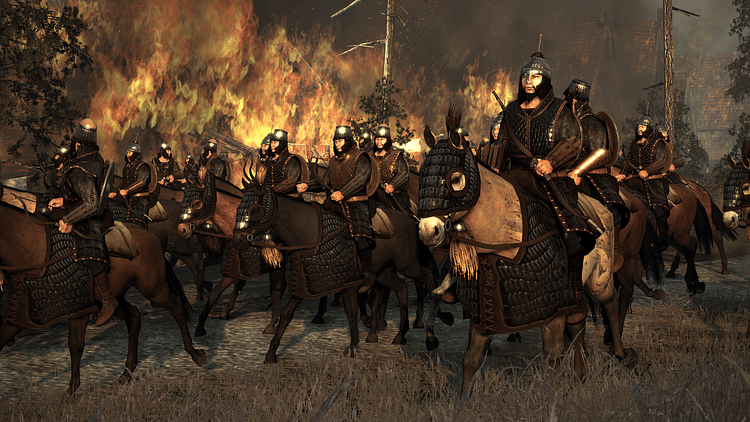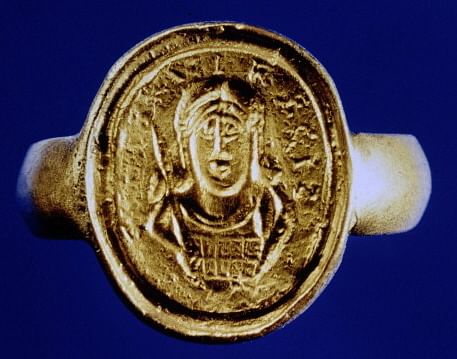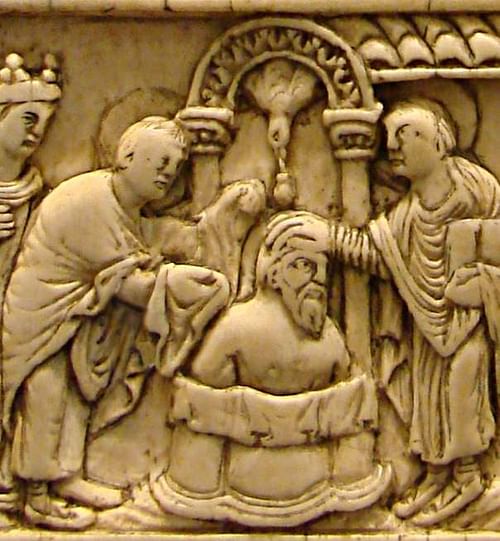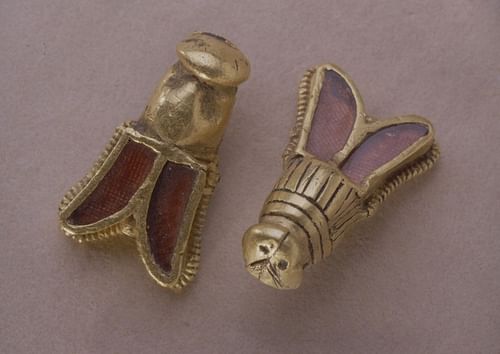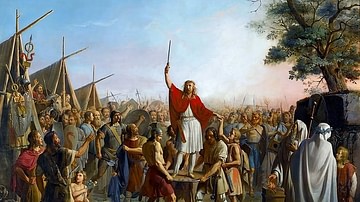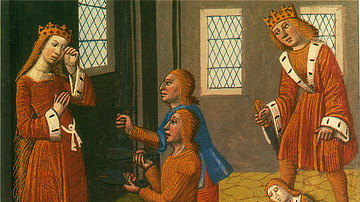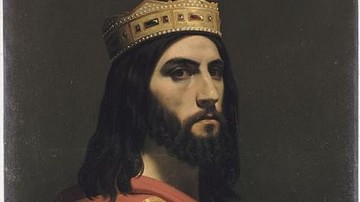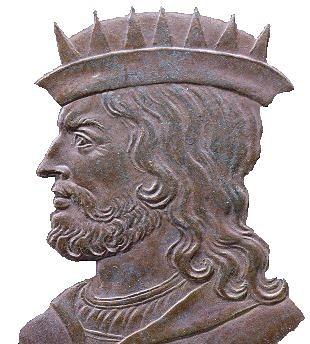
Childeric I (r. c. 458-481) was a late antiquity king of the Salian Franks during the period of the fall of the Western Roman Empire. Childeric's reign solidified the Salians as a dominant Frankish tribe and helped pave the way for the unification of the Franks under his son and successor, Clovis I (r. 481-511), founder of the Merovingian Dynasty.
Childeric ruled over territory that roughly corresponded to the old Roman province of Belgica Secunda, a region stretching from Tournai and Cambrai in the north to the Somme in the south. The details of his rule remain murky, but he is closely associated with Roman military campaigns along the Loire River, and with the Roman general Aegidius, who defeated the Visigoths at the Battle of Orleans in 463 CE. The exact nature of Childeric's relationship with the Romans remains unknown; he could have been a Roman client, an ally, or may have never been aligned with them at all.
Childeric I reigned as an early Merovingian king who bridged the gap between two eras: the period of Roman dominance in Gaul, when the Franks acted alternatively as Roman allies and enemies, and the period of Frankish unity and expansion, a process that was begun by Clovis.
Background: Romans & Franks
The relationship between the Roman Empire and the Frankish tribes was complicated and ever-changing. The Franks entered the Roman annals as enemies during the late 3rd century CE, participating in violent and destructive incursions into Roman territory. They became enough of a thorn in Rome's side to demand the attention of the emperors, and the late 3rd and early 4th centuries saw several successful campaigns against the Franks conducted first by Roman emperor Maximian (r. 286-305) and later by Constantius Chlorus (r. 305-306). The latter decided to settle Frankish prisoners of war on Roman territory as laeti, or foreigners given land in return for military service.
Due to the presence of the laeti and of certain tribes settled on Roman land under similar foederati treaties, individual Franks embarked on long and successful careers in the Roman army. Probably beginning during the reign of Constantine the Great (r. 306-337), men of Frankish descent began attaining high offices within the Roman Empire. Merobaudes, for example, was a Frank who became consul at least twice in the west, while Silvanus was a Frankish general who supported Constantine in the civil war against Licinius but was later killed after trying to usurp the throne. Arbogast, who had a Frankish father, came to rule the Western Roman Empire in all but name, overseeing administrative tasks and reporting little to Emperor Valentinian II (r. 375-392), who curiously died shortly after trying and failing to remove Arbogast from power. Arbogast himself was killed in the Battle of the Frigidus River in 394 while fighting an Eastern Roman army commanded by Stilicho, another barbarian general.
The success of these individual Franks did little for the Frankish people as a whole. Men like Merobaudes and Arbogast had become too thoroughly Romanized to care about the interests of their people, whom they regarded as barbarians. Yet the incursion of Frankish soldiers into the Roman power structure reflected the prevalence of Frankish tribes on Roman soil; the Salian Franks made peace with Rome in 358 and were subsequently given land to settle just west of the lower Rhine. Likewise, the Ripuarian (or Rhineland) Franks may have entered a similar agreement with Rome to defend the middle Rhine in return for land there, and centered their territory around Cologne.
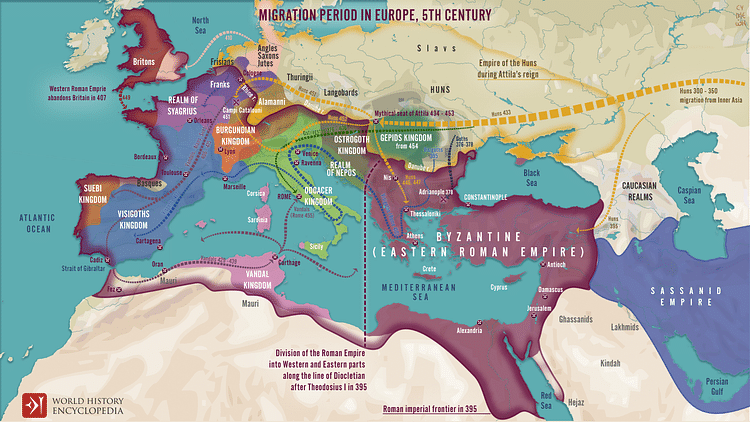
These agreements undoubtedly had advantages for Rome; in 451, the Franks fought alongside Roman general Flavius Aetius against the Huns in the Battle of the Catalaunian Fields and helped end the Hunnic threat to western Europe. But the unintended side effect was that the Western Roman Empire was becoming less Roman, as the sacred line between 'civilization' and 'barbarian' became increasingly blurred. Discoveries of Frankish cemeteries suggest that by the 400s large numbers of Franks had settled in Roman Gaul as foederati, bringing their wives and children with them. As the Roman grip on Gaul was loosening, it was becoming clearer that the Franks were here to stay.
Salians
Before the time of Clovis I, the Franks were not a unified people, but rather a confederation of tribes. Some tribes allied with Rome, fighting in Roman armies as foederati, while others continued raiding the empire's borders; such divisions were driven by intertribal rivalries just as much as desire for land or plunder. One tribe, the Salians, or Salii, had been settled in the Roman Empire by the emperor Julian in 358 and agreed to defend Roman territory against barbarian incursions, which meant the Salians often took up arms against their fellow Franks.
During this time, the Salians expanded their control, taking the cities of Cambrai and Tournai and increasing their territory as far south as the Somme. Led by the semi-mythical Chlodio, the Salians brazenly challenged the power of their Roman benefactors and raided the civitas of Arras, forcing Aetius to check their ambitions by defeating them in battle in 450. By the next year, the Salians were once again fighting with the Romans, having answered Aetius' call to arms in the battle against the Huns. Following Aetius' assassination in 454, Western Roman authority in Gaul rapidly fell apart, and tribes like the Salians were increasingly left to their own devices. Gallo-Roman citizens, in need of protection and employment, began looking to the local foederati nations instead of the unstable and distant empire as the basis for authority.
This was the condition of Roman Gaul during the life of Merovech, a leader of the Salian Franks who had fought the Huns on the Cataulanian Fields. His son, Childeric, may have participated in the battle as well. When Merovech died, probably around 458, Childeric ascended to the Salian throne. By this point, the Salians were already the most dominant Frankish tribe, occupying the lands between the Somme and the Flemish coast. Yet enemies were all around, as rival tribes and petty kingdoms scrambled to snatch up the fragments of the shattered Roman Empire.
Childeric's Exile
Childeric I was born sometime around 436 and succeeded to the throne in approximately 458. According to the chroniclers Gregory of Tours and Fredegar, his reign did not get off to a good start. Gregory describes Childeric as a dissolute man whose private life was "one long debauch" (128). Childeric managed to offend his subjects by doing little except seducing their daughters, which led them to rise against him and cast him out of the kingdom. Before going into exile, Childeric charged one of his most loyal followers, Wiomad, to stay behind and soothe Salian tempers with his "honeyed words". Childeric and Wiomad split a coin in half, and each took a part; Wiomad was to send Childeric his half of the coin once it was safe for him to return.
Childeric went to exile in Thuringia as the guest of King Bisinus, where he would remain for eight years. In the meantime, the Salian Franks elected the Roman general Aegidius as their king. Yet Wiomad, true to his promise, used his skills of persuasion to turn the Salians against Aegidius and to make them think fondly of their old king Childeric. Eventually, the Franks came to not only forgive Childeric but to demand his return to the throne. Upon hearing this, Wiomad sent Childeric the other half of the coin, and the king returned from his exile to reclaim his kingdom.
After Childeric's restoration, he was approached by Basina, queen of the Thuringians and wife of his old host Bisinius. Basina proclaimed that she had followed Childeric to Tournai because she was impressed with his boldness and power and wanted him as her new husband. Childeric and Basina were married shortly thereafter. The chronicler Fredegar records that on their wedding night, Basina sent Childeric to look outside where he saw a procession of animals: first came mighty beasts like lions and unicorns, then came bears and wolves, and finally mangy dogs. This was meant to symbolize the steady degeneration of Childeric's descendants, the Merovingian kings, from lion-like rulers to powerless dogs.
Childeric & Aegidius
The exile story appears to be rooted more in myth than reality and is outright rejected by some scholars as fictional. However, as historian Edward James suggests, nuggets of historical truth can be found within this "fairy tale" (68), particularly in relation to Childeric's ties to Rome. The election of the Roman general Aegidius as king of the Franks may suggest a continued relationship between the Franks and the dying Western Roman Empire, even as late as the 460s. Aegidius had been appointed magister militum (master of soldiers) of Gaul by Western Roman Emperor Majorian (r. 457-461), and as such would have represented the dwindling might of Rome in Gaul. Perhaps, under King Childeric, the Franks were either subjected to or allies of Rome, although there is no concrete evidence of this.
Historians who support the theory of Childeric's relationship with Rome cite sources that allege Frankish participation in the campaigns of Aegidius. These campaigns began when Emperor Majorian was assassinated in 461; the culprit, a Romanized Germanic general named Ricimer, installed the senator Libius Severus to be his puppet emperor. However, Majorian's former generals refused to recognize Severus' rule, with Aegidius himself vowing to march on Italy to avenge Majorian's death. He was prevented from doing so by the Visigoths, who invaded Gaul perhaps at the goading of Ricimer. In 463, Aegidius met the Visigoths in battle near Orléans, resulting in a costly Roman victory and the death of the Visigothic commander, Federico. Some sources claim that Aegidius' army was bolstered by Frankish soldiers, who may have been led by King Childeric himself. Gregory of Tours notes in vague terms that Childeric fought "a battle at Orléans", which is interpreted by some historians to be referring to the battle of 463 (132).
Gregory of Tours also notes, again in vague terms, that Childeric was involved in a battle with a certain Count Paul, who commanded Romans and Franks. Count Paul was killed, and Childeric seized the city of Angers. The chronicler Fredegar, who drew from Gregory's work, assumed this to mean that Childeric killed Count Paul, something that modern scholars have rejected on the basis that Childeric was a Roman ally, and therefore would have been on the same side as Count Paul. Again, there is no concrete evidence that Childeric was a Roman ally; but, as James observes, even if he was, this interpretation is not inconsistent. Aegidius' faction of Romans and Ricimer's faction of Romans were at odds, meaning that if Childeric was indeed an ally of Aegidius, he still may have battled Romans allied to Ricimer (James, 69).
In any case, Aegidius died in 465, either in an ambush or while in prison. According to Gregory of Tours, he left behind a son, Syagrius, who ruled the Kingdom of Soissons. The exact nature of Syagrius' 'kingdom' is unknown, but it was probably a Gallo-Roman remnant state that splintered off during the Western Roman Empire's collapse. Whatever the Kingdom of Soissons was, it seemed to have helped check the expansion of Childeric's power, keeping him from expanding south of the old province of Belgica Secunda. Syagrius would later be defeated and killed by Childeric's son, Clovis.
Later Reign
Childeric had at least four children that are named in historical records. Clovis I was his only son (that we know of) and was also the child of Queen Basina. Audofleda, born around 467, became queen of the Ostrogoths when she married Theodoric the Great (r. 493-526) around 493. Two more daughters, Lantechildis and Albofledis, are also mentioned by Gregory of Tours as having converted to Nicene Christianity at the same time that their brother Clovis was baptized.
In Book II of his History of the Franks, Gregory of Tours notes that sometime after Aegidius' death, a group of Saxons under a certain Odovacar penetrated Gaul as far as Angers, from which they took captives. As the Romans fought off the Saxons, the Franks (again, appearing to act as allies of the Romans) captured Saxon-held islands in the River Loire. In the next chapter, Gregory has Childeric enter a treaty of alliance with an Odovacar (it is unclear if it is the same man who led the Saxons) against the Alans who had invaded part of Italy. Together, Childeric and Odovacar defeated the Alans and drove them from Italy.
Some historians have speculated that Gregory was referring to the same Odovacar (or Odoacer) who overthrew Romulus Augustulus and became King of Italy in 476; what Odovacar, of possible Hunnic and Scirian descent, would have been doing leading a band of Saxons is unknown. It has been suggested that the Odovacar who led the Saxons against Angers and the Odovacar who allied with Childeric against the Alans were, in fact, two different people. In any case, James notes that these dealings with Odovacar support the conclusion that:
Childeric and his Franks were indeed playing an important role in the Empire in the 460s and 470s, not, as most historians have argued, spending their time in unimportant skirmishes near the Loire (70).
Childeric's power is exemplified by the hagiographer of the Life of St. Genevieve, written in the 6th century, who claims that Childeric laid siege to Paris over a period of ten years. Although James mentions that this 'siege' may have been nothing more than Childeric's soldiers occupying the land surrounding Paris, it still shows the growth of Frankish power under Childeric's rule and the expansion of Salian influence.
The Life of St. Genevieve goes on to mention that the "pagan Childeric" loved St. Genevieve "with a veneration I cannot express" (James, 66). While it may seem odd that a pagan king would have venerated a Christian saint, there is evidence to suggest that Childeric was pragmatic enough of a politician to remain on good terms with the Christians. In a famous letter written by Bishop Remigius of Rheims to a young Clovis I upon his coronation, Remigius advises Clovis to always listen to the advice of "your bishops" just as his father had done, suggesting that Childeric had heeded the counsel of local Christian clergy. In a legal text written during the reign of Childeric's grandson, Chlothar I, it was stated that Childeric had even built churches and given them immunities. As James writes, this was likely done for purely political reasons, to appease the Franks' Gallo-Roman subjects; the Franks themselves would not convert to Christianity until the reign of King Clovis.
Another assumption that can be made from Bishop Remigius' letter is that Childeric's reign was a long one. The bishop writes to young Clovis:
A strong report has come to us that you have taken over the administration of the Second Belgic Province. There is nothing new in that you now begin to be what your parents always were (James, 65).
James believes that the use of the word 'always' implies that Childeric had ruled over Belgica Secunda for a long time. King Childeric I died in 481 and left his kingdom to Clovis, who would use the groundwork lain by his father to unite all of the Franks beneath his banner.
Childeric's Treasure
King Childeric's grave was discovered in 1653, near Tournai in modern Belgium. The grave is one of the richest royal burials from the early medieval period, containing weapons, jewelry, and large quantities of Roman coins. Notably, there were several gold bees, or cicadas, which had perhaps been used to adorn a cloak; much later, during the First French Empire (1804-1814, 1815) Childeric's bees were adopted as heraldic symbols by Emperor Napoleon I to replace the Capetian fleur-de-lys. A small golden bull's head was also discovered in Childeric's tomb, as well as the king's signet ring and a Roman brooch that was in the style of a high-standing Roman official. The discovery of this brooch lends credence to the claim that Childeric did act as a Roman official in some capacity.
The treasure from Childeric's grave was stored in the French royal library but was among the 176 pounds of treasure stolen from the library in November 1831. A few pieces of the treasure, including two of the bees, were recovered from where they had been hidden in the Seine River. But unfortunately, the rest of Childeric's treasure has been lost and is known today only from the meticulous records that were made upon the tomb's discovery.
Conclusion
The exact nature of the reign of King Childeric I is difficult to analyze, obscured as it is by the fog of history. Whether Childeric acted as a Roman client king, an autonomous ruler in his own right, or whether he was somewhere in the middle, it is clear that his reign marked a bridge between two eras: the period of waning Roman dominance, when the Franks and the Romans alternatively battled with and against one another, and the period of Merovingian rule, when the Franks became the most powerful of the barbarian successor kingdoms.
